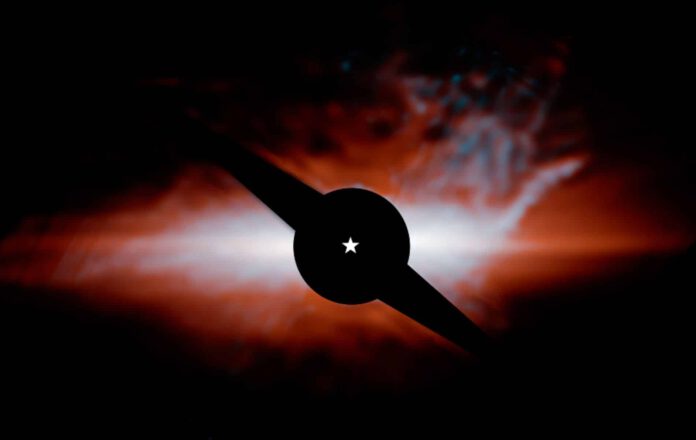
Discovery of an Unobserved Structure Using the James Webb Space Telescope
Researchers using the powerful James Webb Space Telescope have discovered a new, previously unobserved, structure in one of the dust disks surrounding the young star Beta Pictoris.
About Beta Pictoris
Beta Pictoris is a young star located a mere 63 light-years from Earth. Despite being the subject of extensive studies, researchers have now discovered something new: a collection of dust – shaped somewhat like a cat’s tail – protruding from one of the dust disks around Beta Pictoris.
MIRI
The dusty tail-like structure was discovered when researchers examined Beta Pictoris using MIRI. MIRI is an instrument on board the James Webb telescope that can observe radiation in the mid-infrared (wavelengths of several micrometres). “Although Beta Pictoris has previously been observed from Earth at these wavelengths, those terrestrial instruments lacked the sensitivity and resolution that Webb has, so those instruments could not detect this structure (the tail),” explains researcher Isabel Rebollido.
Two Dust Disks
Researchers previously discovered, using other instruments, that Beta Pictoris is surrounded by a debris disk: formed by collisions between, among other things, asteroids and comets. Later observations from the Hubble space telescope revealed the existence of a second debris disk, which is slightly tilted compared to the first disk.
The Collision Theory
Using the James Webb, scientists have now examined both debris disks and discovered that the second disk is marked by a protruding dusty ‘tail’. This ‘tail’ is about 16 billion kilometres long. Based on the brightness of the ‘tail’, researchers estimate that it contains as much dust as a large asteroid. The genesis of the tail is uncertain, but scientists have hypothesized it is the result of a relatively recent collision – one that may have taken place only 100 years ago. “Something happened, a kind of collision, that produced a lot of dust,” says researcher Marshall Periin. “Initially, that dust moves in the same orbit as its source, but later it begins to spread. The star’s light pushes the smallest dust particles away faster, while larger dust particles don’t move as fast. Hence, a long dusty branching is created.”
An Optical Illusion
This branching or tail appears to form a sharp angle relative to the dust disk it emerged from. However, researchers argue this is an optical illusion due to our perspective on Beta Pictoris and the tail’s wavy shape; in reality, the tail where it protrudes from the dust disk creates only a 5-degree angle with the disk.
ALMA and the Tail
The theory that the tail is the result of a recent collision could explain observations by the Atacama Large Millimeter/submillimeter Array (ALMA) from 2014. That year, ALMA spotted a large concentration of carbon monoxide near the now recently discovered tail. As the radiation from the star breaks down carbon monoxide within about 100 years, this still present quantity of gas could bear witness to the same collision that produced the tail. “Our research suggests that Beta Pictoris may be more active and chaotic than we previously thought,” says researcher Christopher Stark.
Surprising Findings
Aside from the ‘tail’, the James Webb telescope has made other discoveries. It reveals the temperature of the two dust disks surrounding Beta Pictoris is different. This implies they also have a different composition. “We did not expect James Webb to reveal that there are two types of material around Beta Pictoris, but MIRI clearly shows us that the material of the second dust disk and tail is warmer than that of the first dust disk,” Stark says. This suggests the material forming this dust disk – and the tail – is very dark, carbon-rich, and porous, similar to materials previously found on the surface of comets and asteroids in our solar system. “James Webb continues to surprise us, even as we look at the best-studied objects,” Stark concludes. “We are now seeing these planetary systems in a whole new light.”











